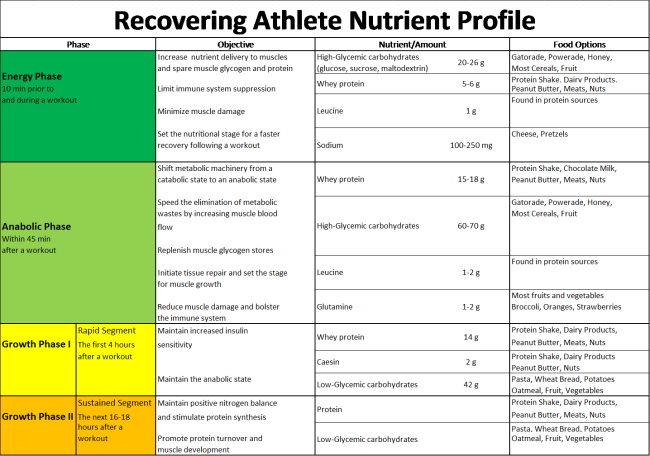By Matthew Van Dyke, Blog Post
Muscle glycogen is needed for rapid energy usage, and becomes depleted after a high intensity training session. Rapid glycogen re-synthesis and protein synthesis are crucial for proper recovery in athletes of all types, particularly for those with practice and lifting sessions within the same day. If an athlete does not take proper actions within the first few hours, particularly in the area of nutrition, optimal gains due to training adaptations cannot be expected. The best examples I have seen to this date have come from the book “Nutrient Timing” by John Ivy in which the recovery phases are broken into three phases. These phases include the energy, anabolic, and growth phases, and all serve a different purpose in the recovery process.
The “energy phase” begins ten minutes prior to the start of training and continues through the end of the session. Nutrients taken during this phase are used to spare any unnecessary use of stored glycogen or branch-chain amino acid (BCAA) degradation during the training session as well as extend endurance. Consuming a high-glycemic carbohydrate, such as glucose or sucrose just prior to, as well as throughout a workout will raise blood glucose and insulin levels as well as decrease blood cortisol levels. A 6% glucose solution, about the same percentage as Gatorade, decreases cortisol levels by 80%. This increase in blood glucose will lead to less use the glycogen stored within the body. Sodium can be supplemented at this time to promote hydration and keep the body within its normal levels. Vitamin C use has been shown to reduce free radical levels within the body. However, it is important to note the body will not experience the same stress levels when Vitamin C is used as a supplement, thus less adaptations will be seen due to training. The “energy phase” is a necessity for setting the stage for a proper, rapid recovery.
The second phase is known as the “anabolic stage” and begins promptly at the termination of training and continues for around forty-five minutes post-training. Proper nutrition in this phase causes the biggest impact in terms of recovery and growth. Once this phase ends, the greatest window of opportunity for rapid glycogen replenishment has been lost. After a training session your body is still in the process of breaking down glycogen so one of the purposes of this stage is to turn this catabolic state into an anabolic state, or a “building” state. This is achieved by stimulating the release of insulin, which is one of, if not the most important anabolic hormone involved in the muscle-building process. During this stage of recovery muscles are more sensitive to insulin and its anabolic effects than any other time during the recovery process. High-glycemic carbohydrates, such as glucose or a glucose/fructose mix sports drink are optimal for promoting the greatest insulin response. The greater the insulin response post-training the higher the rate of glycogen re-synthesis will be. Nitric oxide, a strong stimulator of vasodilation, will remain elevated post-exercise for some time. This increase in blood flow will assist in the removal of metabolic wastes within the muscle. Protein is the other major nutrient source needed within the body at this time. The protein in this phase is used to assist with any muscle tissue damage that may have occurred during the training session as well as begin the protein synthesis process. It is important to use either a 3:1 or 4:1 ratio of high-glycemic carbohydrate to protein intake, which are optimal for glycogen and protein synthesis.
The final stage of the recovery process is the “growth phase” and is actually split into two categories with the “rapid segment” coming first and the “sustained segment” being second. The “rapid segment” phase occurs once the “anabolic phase” has ended and can, if proper nutrition is used, to continue for up to four hours after the training session has ended. The goal of this phase is to extend the insulin sensitivity of the muscle cells for as long as possible. Note the difference of wording here in our goal. It is no longer in your best interest to keep your insulin levels as elevated as possible, but rather keep your cells as sensitive as possible. That being said the main nutrient used within this phase is protein. Only a small amount of high-glycemic carbohydrate is needed to maintain insulin sensitivity. The “sustained segment” phase begins when insulin sensitivity is no longer apparent and continues until the “energy phase” is activated just before the next training session. The goals of this final phase are to continue to replenish glycogen stores, maintain a positive nitrogen balance, promote protein turnover and continue muscle development. These goals can be accomplished by supplementing low-glycemic carbohydrates, because insulin sensitivity is no longer a factor, continual intake of protein which will keep the nitrogen balance of the body in the positive as well as continue to promote protein synthesis. These intakes will vary depending on the intensity of the specific athletic event, or the training style that is being used, with higher intensities needing a higher percentage of carbohydrate to sustain activity.
 Clearly the timing of the nutrients, as well as the actual nutrients taken, is highly important for proper recovery post-training. In order to achieve your maximal gains your goals as an athlete must be to spare glycogen and protein break down as much as possible during training, shift the body from a catabolic to an anabolic stage as rapidly as possible, and then continue to promote protein synthesis throughout the remainder of the day until your next training session. These goals can be accomplished by supplementing carbohydrate and protein contained within whole foods throughout your training session. Utilizing a high-glycemic carbohydrate as well as protein in a 3:1 or 4:1 ratio respectively immediately after training, and then continuing to supplement your body with a proper diet throughout the day will allow for maximal adaptations and performances.
Clearly the timing of the nutrients, as well as the actual nutrients taken, is highly important for proper recovery post-training. In order to achieve your maximal gains your goals as an athlete must be to spare glycogen and protein break down as much as possible during training, shift the body from a catabolic to an anabolic stage as rapidly as possible, and then continue to promote protein synthesis throughout the remainder of the day until your next training session. These goals can be accomplished by supplementing carbohydrate and protein contained within whole foods throughout your training session. Utilizing a high-glycemic carbohydrate as well as protein in a 3:1 or 4:1 ratio respectively immediately after training, and then continuing to supplement your body with a proper diet throughout the day will allow for maximal adaptations and performances.
Reference: Ivy, John, and Robert Portman. Nutrient Timing: The Future of Sports Nutrition. Laguna Beach, CA: Basic Health Publications, 2004. Print.
For more information on Matthew Van Dyke, visit here

Your article helped me a lot, is there any more related content? Thanks!